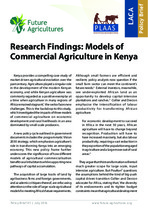| dc.contributor.author | Goldsmith, Paul | |
| dc.date.accessioned | 2019-03-11T07:34:35Z | |
| dc.date.available | 2019-03-11T07:34:35Z | |
| dc.date.issued | 2016 | |
| dc.identifier.citation | Goldsmith, P., 2016. Research findings: Models of commercial agriculture in Kenya, Cape Town: Institute for Poverty Land and Agrarian Studies (PLAAS). | en_US |
| dc.identifier.uri | http://hdl.handle.net/10566/4446 | |
| dc.description.abstract | Kenya provides a compelling case study of market driven agricultural evolution over the past century. Agriculture played a singular role in the development of the modern Kenyan economy, and while Kenyan agriculture was commonly regarded as a positive exemplar at a time when agriculture in many regions of Africa remained stagnant, the sector faces new challenges. This is the backdrop to this study, which investigated the impacts of three models of commercial agriculture on economic development and rural livelihoods in an area dominated by small-scale producers.
A new policy cycle outlined in government documents includes the programmatic Vision 2030 strategy, which emphasises agriculture’s role in transforming Kenya into an emerging economy. This new policy frame further underscores the significance of how different models of agricultural commercialisation benefit rural inhabitants while supporting new pathways of capital accumulation. | en_US |
| dc.language.iso | en | en_US |
| dc.publisher | Institute for Poverty Land and Agrarian Studies (PLAAS) | en_US |
| dc.relation.ispartofseries | FAC Policy Brief;85 | |
| dc.subject | Commercial agriculture | en_US |
| dc.subject | Kenya | en_US |
| dc.title | Research findings: Models of commercial agriculture in Kenya | en_US |
| dc.type | Other | en_US |

